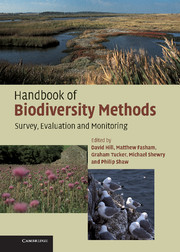Book contents
- Frontmatter
- Contents
- Preface
- Acknowledgements
- Part I Planning
- Part II Habitats
- 4 Introduction to habitat evaluation
- 5 Habitat requirements and issues
- 6 Methods for surveying habitats
- 7 Surveying and monitoring management or environmental impacts
- 8 Habitat conservation evaluation criteria
- Part III Species
- Appendix 1 Monitoring and reporting obligations under international conservation agreements
- Appendix 2 Relationship between BAP Priority Habitat and Broad Habitat categories and Habitats Directive nomenclature
- Appendix 3 Annotated list of key references for plant identification
- Appendix 4 Determining appropriate quadrat size for vegetation sampling
- Appendix 5 The relocation of permanent plots
- Appendix 6 Equipment required for undertaking different types of survey
- Recommended sources of further information
- References
- Glossary
- Index
6 - Methods for surveying habitats
Published online by Cambridge University Press: 01 September 2010
- Frontmatter
- Contents
- Preface
- Acknowledgements
- Part I Planning
- Part II Habitats
- 4 Introduction to habitat evaluation
- 5 Habitat requirements and issues
- 6 Methods for surveying habitats
- 7 Surveying and monitoring management or environmental impacts
- 8 Habitat conservation evaluation criteria
- Part III Species
- Appendix 1 Monitoring and reporting obligations under international conservation agreements
- Appendix 2 Relationship between BAP Priority Habitat and Broad Habitat categories and Habitats Directive nomenclature
- Appendix 3 Annotated list of key references for plant identification
- Appendix 4 Determining appropriate quadrat size for vegetation sampling
- Appendix 5 The relocation of permanent plots
- Appendix 6 Equipment required for undertaking different types of survey
- Recommended sources of further information
- References
- Glossary
- Index
Summary
GENERAL HABITAT SURVEY AND MONITORING METHODS
The methods described in Section 6.1 may be applied to the surveying and monitoring of most habitat types. Section 6.1.1 provides an overview of remote sensing technology, which includes both satellite-based remote sensing (Section 6.1.2) and aerial photography (Section 6.1.3). Remote sensing, Phase I habitat mapping (Section 6.15) and National Vegetation Classification (NVC) surveys (Section 6.16) are principally survey techniques for mapping and/or quantifying the extent of different habitats at a variety of scales. This may be carried out for a number of different purposes:
audits of habitat resources;
the production of maps for management plans; and
general recording of changes in landscapes and habitats, e.g. to document the result of land-use changes or management practices.
Such methods may also be used for basic monitoring of the presence, extent and distribution of habitats. Knowledge of the distribution and extent of habitats and vegetation types is useful for identifying site features and their approximate boundaries, defining monitoring units, defining homogeneous strata for stratified random sampling and locating samples within defined habitats of strata.
Remote sensing principles
The term ‘environmental remote sensing’ covers all means of detecting and measuring environmental conditions from a distance. There is a huge variety of remote sensing instruments currently available, which cover both imaging and non-imaging systems. This section covers only imaging systems. The principal differences between these systems relate to their:
modes of data collection (e.g cameras, scanners, radars etc.);
storage media (film or digital); and the
platforms from which the instrument operates (aircraft or satellite).
- Type
- Chapter
- Information
- Handbook of Biodiversity MethodsSurvey, Evaluation and Monitoring, pp. 154 - 236Publisher: Cambridge University PressPrint publication year: 2005
- 1
- Cited by



